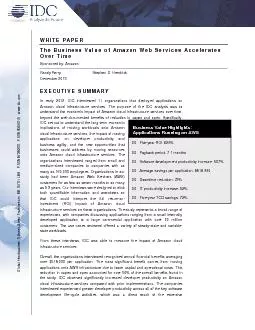PDF-Payback period: 7.1 months
Author : lois-ondreau | Published Date : 2016-02-27
xF079 Five year ROI 626 xF079 xF079 Software development productivity increase 507 xF079 Average s avings per application 9 90 xF079 Downtime reduction 72 xF079 IT
Presentation Embed Code
Download Presentation
Download Presentation The PPT/PDF document "Payback period: 7.1 months" is the property of its rightful owner. Permission is granted to download and print the materials on this website for personal, non-commercial use only, and to display it on your personal computer provided you do not modify the materials and that you retain all copyright notices contained in the materials. By downloading content from our website, you accept the terms of this agreement.
Payback period: 7.1 months: Transcript
Download Rules Of Document
"Payback period: 7.1 months"The content belongs to its owner. You may download and print it for personal use, without modification, and keep all copyright notices. By downloading, you agree to these terms.
Related Documents














